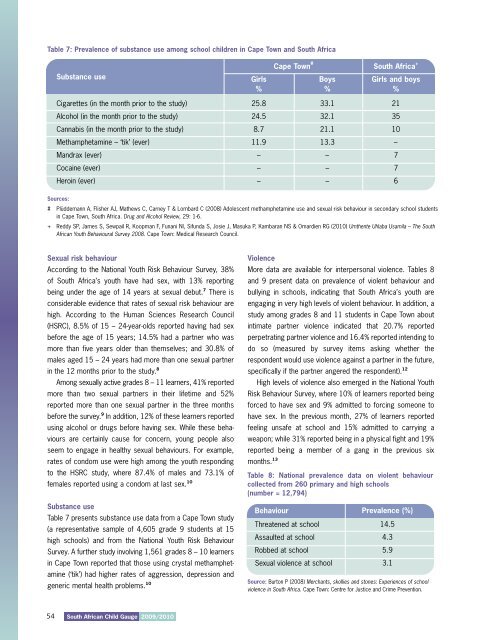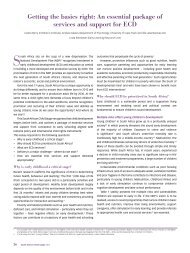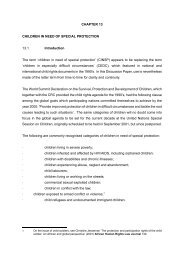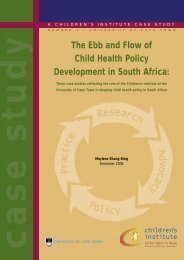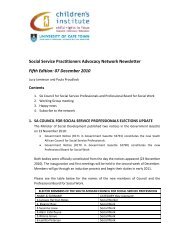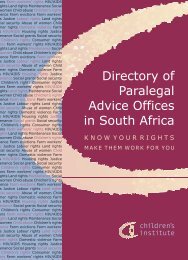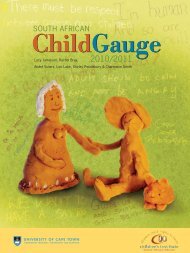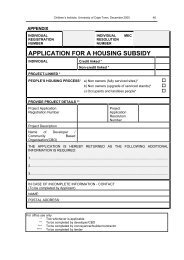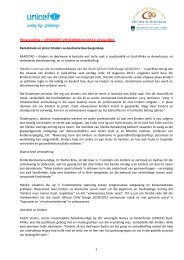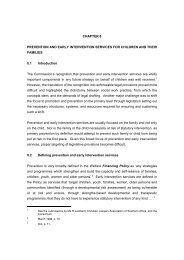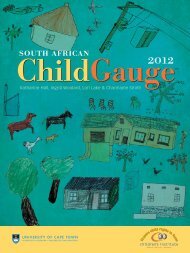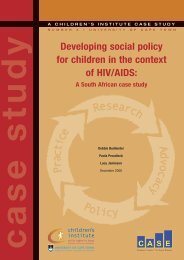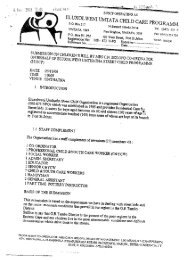Mental health and risk behaviour
Mental health and risk behaviour
Mental health and risk behaviour
Create successful ePaper yourself
Turn your PDF publications into a flip-book with our unique Google optimized e-Paper software.
Table 7: Prevalence of substance use among school children in Cape Town <strong>and</strong> South Africa<br />
Substance use<br />
Cape Town # South Africa +<br />
Girls Boys Girls <strong>and</strong> boys<br />
% % %<br />
Cigarettes (in the month prior to the study) 25.8 33.1 21<br />
Alcohol (in the month prior to the study) 24.5 32.1 35<br />
Cannabis (in the month prior to the study) 8.7 21.1 10<br />
Methamphetamine – ‘tik’ (ever) 11.9 13.3 –<br />
M<strong>and</strong>rax (ever) – – 7<br />
Cocaine (ever) – – 7<br />
Heroin (ever) – – 6<br />
Sources:<br />
# Plüddemann A, Flisher AJ, Mathews C, Carney T & Lombard C (2008) Adolescent methamphetamine use <strong>and</strong> sexual <strong>risk</strong> <strong>behaviour</strong> in secondary school students<br />
in Cape Town, South Africa. Drug <strong>and</strong> Alcohol Review, 29: 1-6.<br />
+ Reddy SP, James S, Sewpail R, Koopman F, Funani NI, Sifunda S, Josie J, Masuka P, Kambaran NS & Omardien RG (2010) Umthente Uhlaba Usamila – The South<br />
African Youth Behavioural Survey 2008. Cape Town: Medical Research Council.<br />
Sexual <strong>risk</strong> <strong>behaviour</strong><br />
According to the National Youth Risk Behaviour Survey, 38%<br />
of South Africa’s youth have had sex, with 13% reporting<br />
being under the age of 14 years at sexual debut. 7 There is<br />
considerable evidence that rates of sexual <strong>risk</strong> <strong>behaviour</strong> are<br />
high. According to the Human Sciences Research Council<br />
(HSRC), 8.5% of 15 – 24-year-olds reported having had sex<br />
before the age of 15 years; 14.5% had a partner who was<br />
more than five years older than themselves; <strong>and</strong> 30.8% of<br />
males aged 15 – 24 years had more than one sexual partner<br />
in the 12 months prior to the study. 8<br />
Among sexually active grades 8 – 11 learners, 41% reported<br />
more than two sexual partners in their lifetime <strong>and</strong> 52%<br />
reported more than one sexual partner in the three months<br />
before the survey. 9 In addition, 12% of these learners reported<br />
using alcohol or drugs before having sex. While these <strong>behaviour</strong>s<br />
are certainly cause for concern, young people also<br />
seem to engage in <strong>health</strong>y sexual <strong>behaviour</strong>s. For example,<br />
rates of condom use were high among the youth responding<br />
to the HSRC study, where 87.4% of males <strong>and</strong> 73.1% of<br />
females reported using a condom at last sex. 10<br />
Substance use<br />
Table 7 presents substance use data from a Cape Town study<br />
(a representative sample of 4,605 grade 9 students at 15<br />
high schools) <strong>and</strong> from the National Youth Risk Behaviour<br />
Survey. A further study involving 1,561 grades 8 – 10 learners<br />
in Cape Town reported that those using crystal methamphetamine<br />
(‘tik’) had higher rates of aggression, depression <strong>and</strong><br />
generic mental <strong>health</strong> problems. 10<br />
Violence<br />
More data are available for interpersonal violence. Tables 8<br />
<strong>and</strong> 9 present data on prevalence of violent <strong>behaviour</strong> <strong>and</strong><br />
bullying in schools, indicating that South Africa’s youth are<br />
engaging in very high levels of violent <strong>behaviour</strong>. In addition, a<br />
study among grades 8 <strong>and</strong> 11 students in Cape Town about<br />
intimate partner violence indicated that 20.7% reported<br />
perpetrating partner violence <strong>and</strong> 16.4% reported intending to<br />
do so (measured by survey items asking whether the<br />
respondent would use violence against a partner in the future,<br />
specifically if the partner angered the respondent). 12<br />
High levels of violence also emerged in the National Youth<br />
Risk Behaviour Survey, where 10% of learners reported being<br />
forced to have sex <strong>and</strong> 9% admitted to forcing someone to<br />
have sex. In the previous month, 27% of learners reported<br />
feeling unsafe at school <strong>and</strong> 15% admitted to carrying a<br />
weapon; while 31% reported being in a physical fight <strong>and</strong> 19%<br />
reported being a member of a gang in the previous six<br />
months. 13<br />
Table 8: National prevalence data on violent <strong>behaviour</strong><br />
collected from 260 primary <strong>and</strong> high schools<br />
(number = 12,794)<br />
Behaviour Prevalence (%)<br />
Threatened at school 14.5<br />
Assaulted at school 4.3<br />
Robbed at school 5.9<br />
Sexual violence at school 3.1<br />
Source: Burton P (2008) Merchants, skollies <strong>and</strong> stones: Experiences of school<br />
violence in South Africa. Cape Town: Centre for Justice <strong>and</strong> Crime Prevention.<br />
54<br />
South African Child Gauge 2009/2010


